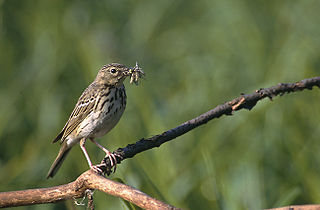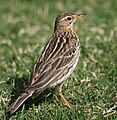
The cuckoo, common cuckoo, European cuckoo or Eurasian cuckoo is a member of the cuckoo order of birds, Cuculiformes, which includes the roadrunners, the anis and the coucals.

The pipits are a cosmopolitan genus, Anthus, of small passerine birds with medium to long tails. Along with the wagtails and longclaws, the pipits make up the family Motacillidae. The genus is widespread, occurring across most of the world, except the driest deserts, rainforest and the mainland of Antarctica.

The wagtails, longclaws, and pipits are a family, Motacillidae, of small passerine birds with medium to long tails. Around 70 species occur in five genera. The longclaws are entirely restricted to the Afrotropics, and the wagtails are predominantly found in Europe, Africa, and Asia, with two species migrating and breeding in Alaska. The pipits have the most cosmopolitan distribution, being found mostly in the Old World, but occurring also in the Americas and oceanic islands such as New Zealand and the Falklands. Two African species, the yellow-breasted pipit and Sharpe's longclaw, are sometimes placed in a separate seventh genus, Hemimacronyx, which is closely related to the longclaws.

The European rock pipit, or simply rock pipit, is a species of small passerine bird that breeds in western Europe on rocky coasts. It has streaked greyish-brown upperparts and buff underparts, and is similar in appearance to other European pipits. There are three subspecies, of which only the Fennoscandian one is migratory, wintering in shoreline habitats further south in Europe. The European rock pipit is territorial at least in the breeding season, and year-round where it is resident. Males will sometimes enter an adjacent territory to assist the resident in repelling an intruder, behaviour only otherwise known from the African fiddler crab.

The water pipit is a small passerine bird which breeds in the mountains of Southern Europe and the Palearctic eastwards to China. It is a short-distance migrant; many birds move to lower altitudes or wet open lowlands in winter.

Richard's pipit is a medium-sized passerine bird which breeds in open grasslands in the East Palearctic. It is a long-distance migrant moving to open lowlands in the Indian subcontinent and Southeast Asia. It is a rare but regular vagrant to western Europe.

Blyth's pipit is a medium-sized passerine bird which breeds in Mongolia and neighbouring areas of China, Tibet and India. It is a long distance migrant moving to open lowlands in Southern Asia. It is a very rare vagrant to western Europe.

The meadow pipit is a small passerine bird, which breeds in much of the Palearctic, from southeastern Greenland and Iceland east to just east of the Ural Mountains in Russia, and south to central France and Romania; an isolated population also occurs in the Caucasus Mountains. It is migratory over most of its range, wintering in southern Europe, North Africa, and south-western Asia, but is resident year-round in western Europe, though even here many birds move to the coast or lowlands in winter.

The tawny pipit is a medium-large passerine bird which breeds in much of the central Palearctic from northwest Africa and Portugal to Central Siberia and on to Inner Mongolia. It is a migrant moving in winter to tropical Africa and the Indian Subcontinent. The scientific name is from Latin. Anthus is the name for a small bird of grasslands, and the specific campestris means "of the fields".

The Pechora pipit is a small passerine bird which breeds in the East Palearctic tundra and densely vegetated areas near river banks ranges from the Pechora River to the Chukchi Peninsula. It also breeds in Kamchatka and the Commander Islands. It is a long-distance migrant, moving in winter to Indonesia. Rarely in September and October, the Pechora pipit may be observed in western Europe. The species was first described by Robert Swinhoe in 1863.

The tree pipit is a small passerine bird which breeds across most of Europe and the Palearctic as far East as the East Siberian Mountains. It is a long-distance migrant moving in winter to Africa and southern Asia. The scientific name is from Latin: anthus is the name for a small bird of grasslands, and the specific trivialis means "common".

The olive-backed pipit is a small passerine bird of the pipit (Anthus) genus, which breeds across southern, north central and eastern Asia, as well as in the north-eastern European Russia. It is a long-distance migrant moving in winter to southern Asia and Indonesia. Sometimes it is also called Indian pipit or Hodgson's pipit, as well as tree pipit owing to its resemblance with the tree pipit. However, its back is more olive-toned and less streaked than that species, and its head pattern is different with a better-marked supercilium.

The buff-bellied pipit or American pipit is a small songbird found on both sides of the northern Pacific. It was first described by Marmaduke Tunstall in his 1771 Ornithologia Britannica. It was formerly classified as a form of the water pipit. It is known as "American pipit" in North America and "buff-bellied pipit" in Eurasia.

The paddyfield pipit or Oriental pipit is a small passerine bird in the pipit and wagtail family. It is a resident (non-migratory) breeder in open scrub, grassland and cultivation in southern Asia east to the Philippines. Although among the few breeding pipits in the Asian region, identification becomes difficult in winter when several other species migrate into the region. The taxonomy of the species is complex and has undergone considerable changes.

Sharpe's longclaw is a passerine bird in the longclaw family Motacillidae, which also includes the pipits and wagtails. It is endemic to Kenya.

Sprague's pipit is a small songbird (passerine) in the family Motacillidae that breeds in the short- and mixed-grass prairies of North America. Migratory, it spends the winters in the southwestern United States and northern Mexico. Sprague's pipits are unusual among songbirds in that they sing high in the sky, somewhat like a goldfinch or skylark. It is more often identified by its distinctive descending song heard from above than by being seen on the ground. Males and females are cryptically coloured and similar in appearance; they are a buffy brown with darker streaking, slender bills and pinkish to yellow legs. Sprague's pipit summer habitat is primarily native grasslands in the north central prairies of the United States and Canada. The species was named after the botanical illustrator Isaac Sprague.

The Nilgiri pipit is a distinctive species of pipit that is endemic to the high altitude hills of southern India. Richer brown in colour than other pipits in the region, it is distinctive in having the streaking on the breast continuing along the flanks. It is non-migratory and has a tendency to fly into low trees when disturbed and is closely related to the tree pipits Anthus hodgsoni and Anthus trivialis.

The African pipit is a fairly small passerine bird belonging to the pipit genus Anthus in the family Motacillidae. It is also known as the grassveld pipit or grassland pipit. It was formerly lumped together with the Richard's, Australian, mountain and paddyfield pipits in a single species, Richard's pipit, but is now often treated as a species in its own right.

The yellow tufted pipit or African rock pipit is a small-sized, passerine bird that is native to South Africa and Lesotho. The yellow tufted pipit is commonly found in mountain terrain, and they create their habitats in high-altitude shrub-land, grassland, and rocky areas. The yellow tufted pipit is identified by its brown and gray feathers. The bird has a white-gray eyebrow and yellow markings within its wings and stomach. The call of the yellow tufted pipit allows the bird to stand out from other pipit species. The bird produces a repeated “whee-tsrreeu” that is loud and high-pitched. The yellow tufted pipit has a life expectancy ranging from two to three years old.

Hellmayr's pipit is a species of bird in the family Motacillidae. It is found in Argentina, Bolivia, Brazil, Chile, Paraguay, Peru, and Uruguay. Its natural habitats are temperate grassland, subtropical or tropical high-altitude grassland, and pastureland.























